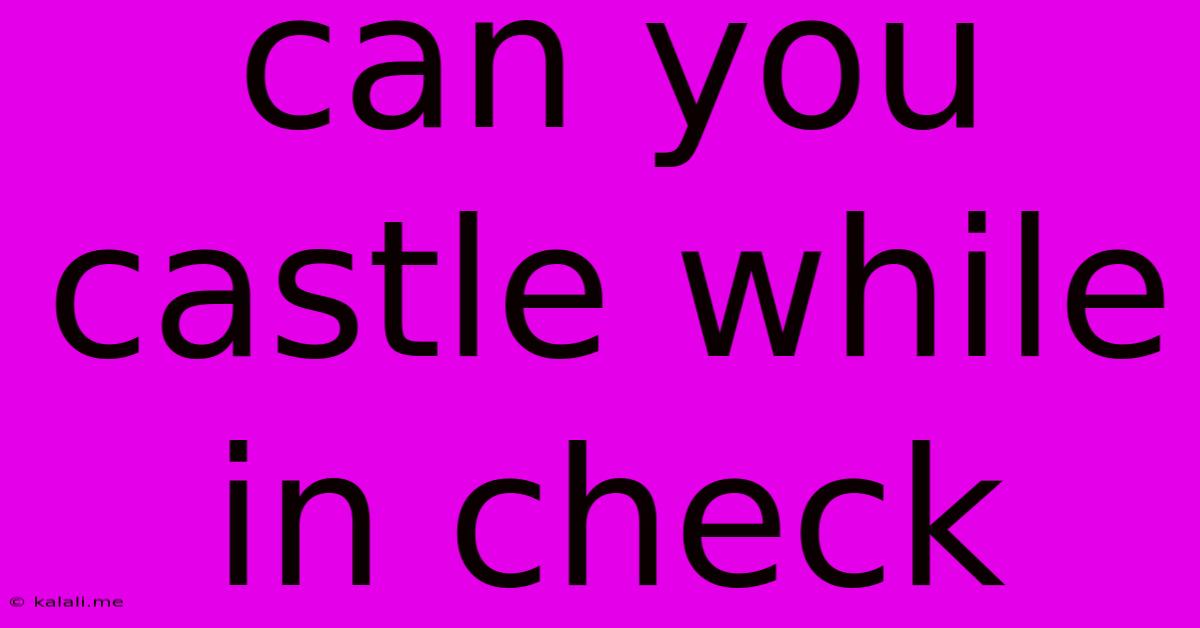Can You Castle While In Check
Kalali
May 22, 2025 · 3 min read

Table of Contents
Can You Castle While in Check? A Comprehensive Guide to Chess Castling
Meta Description: Learn the rules of castling in chess. This guide clarifies whether you can castle while your king is in check, covering exceptions and common misconceptions. Master this crucial chess strategy!
Castling is a crucial strategic move in chess, allowing you to quickly safeguard your king and get your rooks into the game. However, the rules surrounding castling can be tricky, especially for beginners. One common question is: can you castle while in check? The short answer is no. This article will delve deeper into the specifics of castling and explain why this isn't allowed, alongside other crucial rules to remember.
Understanding the Rules of Castling
Before we address the central question, let's review the basic rules of castling. Castling involves moving your king two squares towards one of your rooks, and then placing the rook on the square that the king passed over. This move can only be performed under specific conditions:
- Neither the king nor the rook involved in castling has previously moved. This is a crucial rule. Once either piece moves, castling with that side is no longer an option.
- There are no pieces between the king and the rook. The path between the king and the rook must be clear.
- The king is not in check. This is the core of our discussion. You cannot castle out of check.
- The king does not pass through a square that is under attack. Even if the king's starting square and ending square are safe, the path must be entirely free from enemy attacks.
- The king does not end up in check. After castling, the king cannot be in check.
Why You Can't Castle While in Check
The rule prohibiting castling while in check is fundamental to the game's fairness and strategy. Imagine if you could castle out of check; this would render the check itself almost meaningless. It would create a loophole that dramatically favors the player under attack, eliminating a key element of tactical chess. The game's designers intentionally created this restriction to prevent such an imbalance.
Common Misconceptions About Castling
Many beginners misinterpret the rules of castling. Some common misunderstandings include:
- Castling through check: You cannot move through a square attacked by an opponent's piece. The entire path from the king's starting position to its final position must be safe.
- Castling into check: The king's final position after castling cannot be under attack.
- Castling after being checked: Even if you were previously in check and then the threat is removed, you still cannot castle if any of the other castling conditions are not met (e.g., the king or rook has already moved).
Mastering Castling: Strategic Implications
Understanding the nuances of castling is crucial for effective chess play. It's often a critical part of the opening, providing a safe haven for your king and bringing your rooks into play quickly. However, remember that premature castling can also leave your king vulnerable, so timing is key. Consider your opponent's pieces and potential attacks before committing to this powerful move. Knowing when not to castle, just as much as when to castle, demonstrates strategic prowess.
Conclusion
Castling is a powerful move in chess, but it's essential to fully grasp its rules and limitations. Remember, you cannot castle while in check, nor can you move through a square that is under attack. By understanding these rules and considering the strategic implications, you can significantly improve your chess gameplay and avoid costly mistakes.
Latest Posts
Latest Posts
-
How To Add Addresses To Google Maps
May 22, 2025
-
How To Sync Wii Balance Board
May 22, 2025
-
Three Sheets To The Wind Etymology
May 22, 2025
-
The Pen Is Mightier Than The Sword Who Said
May 22, 2025
-
Duty Free Paris Charles De Gaulle
May 22, 2025
Related Post
Thank you for visiting our website which covers about Can You Castle While In Check . We hope the information provided has been useful to you. Feel free to contact us if you have any questions or need further assistance. See you next time and don't miss to bookmark.